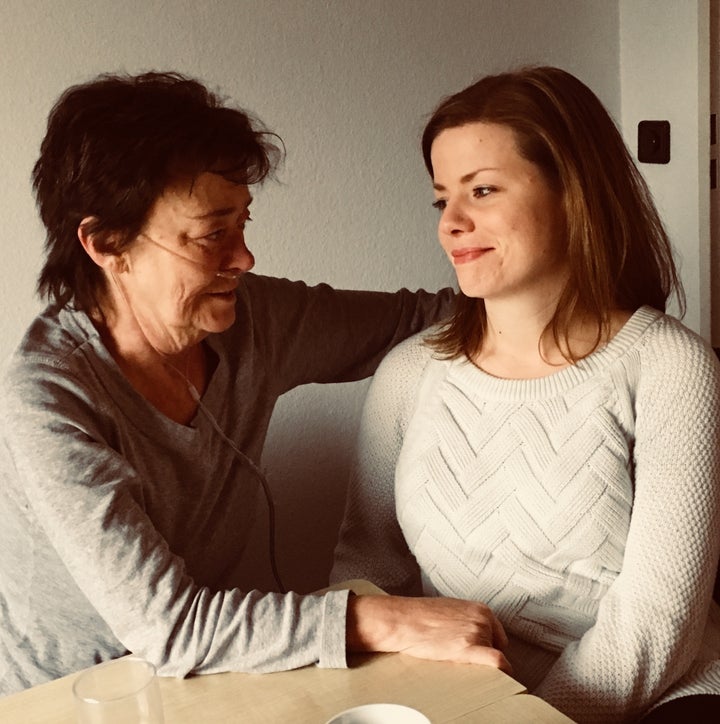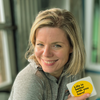
The music video for “Crazy” by Aerosmith was released in 1994. It’s a guy’s standard lesbian porn fantasy, featuring schoolgirl uniforms, pillow fights and “amateur night” at the strip club. My reaction to it at age 40: Ew. But as a teen, I watched this video a million times, sucking in my breath through my teeth at the implied sexual tension between Alicia Silverstone and Liv Tyler.
I desperately hoped they would kiss. (They never did.)
My crushes on boys had been obvious and intense. They were physical, hormonal, obsessive aches that I could easily identify. I barely noticed how often I looked across a crowd at a girl and thought, Oh my God, she’s fucking beautiful. In my head, I translated these feelings as “I want to be her,” not “I want to be with her.”
And yet here I am at 40, a mom of six, in a committed decade-long partnership with a man, finally coming out as queer.
Maybe the delay would make sense if I’d grown up in a religious or conservative family. Instead, I lived with my single mom, the most liberal certified hippie you can imagine. I was also born and raised in Germany, often hailed as one of the most LGBTQ-friendly countries in the world, although this was more true of big cities than the small town I lived in.
When one of my mom’s oldest friends, Carmen, divorced her husband and fell in love with a woman, the three of them sat in our backyard eating cake, drinking coffee, cackling and talking for hours. Armand was my mom’s stylish gay friend before stylish gay friends became a standard TV trope. Mom was loudly supportive of marriage equality.
So why did I spend 25 years in the closet, when I had few repercussions to fear? It’s taken me decades to disentangle.
My mother once told me that her own father had wanted a boy instead of a girl, and so she tried to be the son her dad had wished for. Looking back on her early childhood experience of being rejected for who she was, I can appreciate why equality and feminism meant so much to her, and why she tried so hard to raise me unconstrained by gender norms.
Mom took me to try out a judo class, let me play in the mud and cut my hair with kitchen scissors. One of my earliest memories is crying under the Christmas tree after receiving a toy tool bench instead of the Barbie I’d wished for.
Still, I chose to spend 12 years in a ballet studio wearing sparkly tutus and pointe shoes. I loved baking, decorating my room, wearing my hair long and putting on my mother’s makeup. Growing up, I didn’t understand that gender and sexual orientation were different things. I thought that if I felt feminine, it meant I must like boys exclusively.
It wasn’t until third-wave feminism hit in the mid-’90s that more nuanced conversations opened up about gender identity and performance. By then, I was drowning in full-blown teenage angst, and embracing straightness was easier than listening to the undercurrent that kept whispering, That’s not all; there’s more.
Additionally, my parents struggled with alcohol, drugs and mental illness. My father missed my 1st birthday because he was in jail for growing marijuana. My mother suffered frequent nervous breakdowns. They were both artists at heart (my father a photographer and painter, my mother a writer and sculptor), and were frequently broke and forced to scrape by in dead-end jobs. They were emotionally and mentally unstable, suffering from untreated trauma while trying to provide for a family of four.
They eventually divorced when I was 7, and my father moved back to the States, leaving my single mom behind. In school, I was often the only student whose parents had divorced. I was jealous of all the kids whom I considered to have real families. I yearned for stability and order, which seemed to require holding a respectable job, sweeping the street on Saturdays and, of course, being straight.
Because I never broke curfew or skipped school, didn’t drink or do drugs, I believed that I had just skipped the rebellious stage. I was wrong. Somewhere along the way, I’d started associating anything outside heteronormativity with the chaos of my home and upbringing. So I tried to escape my volatile, unpredictable childhood by distancing myself from what I thought my mom stood for, by choosing what looked safe and acceptable.
Then I did what anyone in my position would do ― I started dating the only Mormon boy of the only Mormon family in my hometown. I saw the Mormon faith, and its focus on the traditional family, as calm, peaceful and ordered, with its strict rules about what to eat and drink, when to work and how to dress. He broke up with me after high school to go on a two-year mission for the church.
I started college heartbroken, only to fall in love with an American missionary and get officially baptized. I was 21 when I dropped out of college in 2003 and moved from Germany to the U.S. to be with him. We married in 2004 and had four children in close succession. I became a full-time, stay-at-home mom. The heteronormative life I’d chosen was largely a big “fuck you” to my mother. But in my attempt to be different from her, I inadvertently rejected parts of myself. I wanted so badly to be perfect, to be a good girl.
I needed to soothe my hypervigilance and anxiety so desperately that I had devoted a decade to an organization whose principles inflicted real and lasting damage on the LGBTQ+ community. That is, until 2008, when our church was involved in passing California’s Proposition 8 to ban same-sex marriage by soliciting donations from members, encouraging them to vote against marriage equality and asking them to advocate within their own families and communities.
Up until then, I’d largely ignored the church’s stance on homosexuality, which tolerated “same-sex attraction” as long as members didn’t act on their feelings. In a church solely focused on eternal families, queer members were expected to deny their sexual identity and stay celibate forever, foregoing physical intimacy, marriage and parenthood.
It was Facebook’s heyday, and I spent my kids’ nap time going down internet rabbit holes, joining groups like “Feminist Mormon Housewives” and private groups for Mormons who were questioning their sexual identity, and doubting church principles like gender inequality and plural marriage. I met other doubters on the fringes of Mormonism who were braver than me, who spoke up courageously and accepted me in all my messiness and confusion. In a way, they saved me.
I’d been struggling with panic attacks and depression so severe, I thought of crashing my van into a pole. The depth of my despair and suicidal ideation terrified me, but it also led me to consider whether my mental state had anything to do with the false identity, doomed marriage and restrictive church I’d chosen. I closeted myself looking for safety, but I almost suffocated instead. As an act of self-preservation, I eventually contemplated divorce and leaving my faith. It was still years before I could finally extricate myself from my marriage and the church in 2011.
One of my ex-husband’s family members openly wondered whether we’d divorced because I was gay, and I felt a strange need to prove that I wasn’t. So I continued to date men exclusively, eventually starting a new life and a blended family with my current partner.
Understanding my sexuality shouldn’t have been a privilege, but I first had to stabilize myself and attain enough psychological safety that I could even ask the question. When my mother died in 2018, I finally started getting to know myself better through therapy, breath work and writing, slowly unknotting the beautiful and tangled necklace that is my relationship with her. As I excavated myself from the coping mechanisms that masked the real me, I eventually started to wonder why I felt so much resistance surrounding my sexual identity.
Still, the realization that I was queer didn’t come suddenly. I slowly gathered fragments of memories and conversations and feelings like shards of a mosaic, and then I stepped back to reveal the new whole. When I first told my partner of 10 years, shortly after I turned 39 in 2021, his curiosity and acceptance allowed me to go deeper in evolving my understanding of who I am. Next I told my sister, whose “Yeah, and?” response confirmed how much of a nonissue my sexual preferences have been in our lifelong bond.
After coming out to her family as a lesbian, a friend of mine told me that she hoped for a future where “coming out” wasn’t necessary anymore, because homosexuality would no longer be considered “other,” but just one of the possible options.
I agree with my friend, and yet here I am, finally stepping out of the closet publicly at 40. I made the decision to do so because I rarely read stories like mine that address the complex reasons people self-closet even in LGBTQ-friendly environments.
It sounds ridiculous to say I didn’t come out earlier because my mom would have been too happy if I turned out queer. But the stress of growing up in a dysfunctional family made my brain do weird gymnastics to protect me. I associated heteronormativity with the safe life I desperately wanted, and queerness with the unpredictable chaos I was trying to escape.
Parenting my own kids, I’ve kept my mother’s ideas of equality and freedom of expression, but I try to ask questions more than I state opinions. I stay away from black-and-white language, having learned that identity and orientation are fluid and evolving, and often situated in messy gray areas. One of the kids hung a gigantic Pride flag above their bed, but they never “came out” to us officially. There was no need. Like I discussed with my school friend years ago, in our house, being queer is simply one of many, equally valid options.
In the five years since my mother’s death, I’ve learned to accept our relationship for what it was ― complicated and flawed, but also full of love.
I never had the opportunity to discuss my queerness with her, since she died years before I understood myself enough to articulate it. If she were still alive today, I’d tell her about it, but I’m almost certain it wouldn’t matter. It was our complicated relationship that led me to finally recover these missing parts of me. As a result, I feel closer to her now than when she was alive.
My mother did for me in death what I hope to do for my children in life ― encourage them to be who they truly are.
If you or someone you know needs help, dial 988 or call 1-800-273-8255 for the National Suicide Prevention Lifeline. You can also get support via text by visiting suicidepreventionlifeline.org/chat. Additionally, you can find local mental health and crisis resources at dontcallthepolice.com. Outside of the U.S., please visit the International Association for Suicide Prevention.
Do you have a compelling personal story you’d like to see published on HuffPost? Find out what we’re looking for here and send us a pitch.
